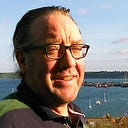Scientists in shimmering white robes
Today’s interesting book is The Penultimate Curiosity: How Science Swims In The Slipstream Of Ultimate Questions by Roger Wagner and Andrew Briggs (Oxford). Not that I’ve got further than the opening pages of Chapter One, but it’s well written, the easiest of reads, and already worthwhile.
Found this in the Prologue. “For medieval thinkers … religio referred to interior acts of devotion, while scientia was considered a habit of mind.”
The concept of ‘religion’, the authors tell us, hardly existed before the seventeenth century, and the word ‘scientist’ was first used in the nineteenth. The opposition between religion and science is a recent invention. An individual could contain religio, so to speak, while looking out at the world with scientia.
This makes sense to me. The notion that “there’s more” fits with both science and spiritual belief (widening this out from ‘religion’, which seems to me a restrictive term) and is probably necessary to both.
‘Religion’ often does, but doesn’t have to, mean signing up to the absolute letter of a doctrine, just as ‘science’ often does, but doesn’t have to, dictate that there is nothing beyond the observable/verifiable. Spiritual belief welcomes you with open arms, and as Mary Oliver put it in Wild Geese, “the world offers itself to your imagination.” Even you, there in the lab.
What if there’s more? What if? That’s all. We’re talking about leaving the possibilities open. Discoveries aren’t made by first deciding that there’s nothing beyond the known limits. Patron saint of this post is the neo-Darwinist geneticist J B S Haldane, who wrote (in 1927), “The universe is not only queerer than we suppose, but queerer than we can suppose.”
And by “queer” Haldane meant something along the lines of “totally awesome, dude” with a side order of “really wasn’t expecting that!” We have a way of being open-minded within limits, don’t we? Scientific enquiry, I suggest, could usefully launch from a notion that absolutely anything might be out there, up to and potentially including — well, yeah. Them. Dancing on the head of a pin.
People who say “I believe that there’s more”, or any such phrase, when they’re asked about their religious beliefs, don’t seem to make it a condition of their belief that the “more” reveals itself. But nor do they quite admit the possibility that the “more” they entertain could be — well. As described, literally and exactly, by theologians. Their “more” approves their lifestyle choices and doesn’t impose too many rules. Really?
It’s good to be open-minded, but part of that is recognising the point at which we become closed-minded. “Oh, come on,” you say, as I suggest either that there’s absolutely nothing or that it’s all literally true. Open-mindedness is a gift; closed-mindedness can be a hidden condition. Being open-minded means admitting the possibility — okay, the very slight possibility — that the closed-minded bigots who disagree with you might be onto something.
G K Chesterton, who is described online as a “journalist-theologian” (he wrote the Father Brown stories) is remembered for saying this. “The problem of disbelieving in God is not that a man ends up believing nothing. Alas, it is much worse. He ends up believing anything.” Which is generally taken to mean that we should stick with the specific and detailed belief system that Chesterton would have known in late 19th/early 20th-century England.
I’d argue that “believing anything,” or at least, being open to anything, is positive. The “problem of disbelieving” in one very specific belief system gives you the opportunity to consider others as well. Chesterton also wrote, “Science must not impose any philosophy, any more than the telephone must tell us what to say,” which might be useful if I ever write about smartphones, and I like him for, “I’ve searched all the parks in all the cities — and found no statues of committees.”
This started out as a review of a book that makes a distinction between religio and scientia and doesn’t find them incompatible. Then it turned into a plea for rigorous open-mindedness. Okay. But I think I’m with Haldane on all of it. The questions are too big. There’s always going to be more. The human condition, or the meaning of life, or whatever you want to call it, is to be constantly searching, constantly asking. Not stubbornly dug in behind a wall of your own certainty. Stay open, stay curious, keep talking.
Maybe there is more beyond the senses we have. Maybe our senses aren’t such a convenient match with everything that could be sensed.
I wonder.
Yes, I did finish the book, thank you. I posted a version of this piece on my website a year or two back, so don’t look for The Penultimate Curiosity: How Science Swims In The Slipstream Of Ultimate Questions, ISBN: 9780198747956, Oxford University Press, under ‘New Titles’. It was first published in 2016 and it even has its own website.
Incidentally, Rodin’s The Burghers of Calais, 1889, is not exactly a statue of a committee, but the story behind it might be worth a moment of your time.
